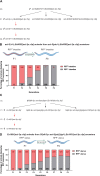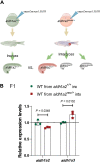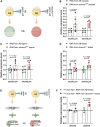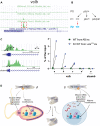Parental mutations influence wild-type offspring via transcriptional adaptation
- PMID: 36427314
- PMCID: PMC9699682
- DOI: 10.1126/sciadv.abj2029
Parental mutations influence wild-type offspring via transcriptional adaptation
Abstract
Transgenerational epigenetic inheritance (TEI) is mostly discussed in the context of physiological or environmental factors. Here, we show intergenerational and transgenerational inheritance of transcriptional adaptation (TA), a process whereby mutant messenger RNA (mRNA) degradation affects gene expression, in nematodes and zebrafish. Wild-type offspring of animals heterozygous for mRNA-destabilizing alleles display increased expression of adapting genes. Notably, offspring of animals heterozygous for nontranscribing alleles do not display this response. Germline-specific mutations are sufficient to induce TA in wild-type offspring, indicating that, at least for some genes, mutations in somatic tissues are not necessary for this process. Microinjecting total RNA from germ cells of TA-displaying heterozygous zebrafish can trigger TA in wild-type embryos and in their progeny, suggesting a model whereby mutant mRNAs in the germline trigger a TA response that can be epigenetically inherited. In sum, this previously unidentified mode of TEI reveals a means by which parental mutations can modulate the offspring's transcriptome.
Figures





References
-
- Skvortsova K., Iovino N., Bogdanovic O., Functions and mechanisms of epigenetic inheritance in animals. Nat. Rev. Mol. Cell Biol. 19, 774–790 (2018). - PubMed
-
- Richards E. J., Inherited epigenetic variation–Revisiting soft inheritance. Nat. Rev. Genet. 7, 395–401 (2006). - PubMed
-
- Daxinger L., Whitelaw E., Understanding transgenerational epigenetic inheritance via the gametes in mammals. Nat. Rev. Genet. 13, 153–162 (2012). - PubMed
-
- Miska E. A., Ferguson-Smith A. C., Transgenerational inheritance: Models and mechanisms of non-DNA sequence-based inheritance. Science 354, 59–63 (2016). - PubMed
MeSH terms
Substances
LinkOut - more resources
Full Text Sources
Molecular Biology Databases
Research Materials

